Churches, Austria
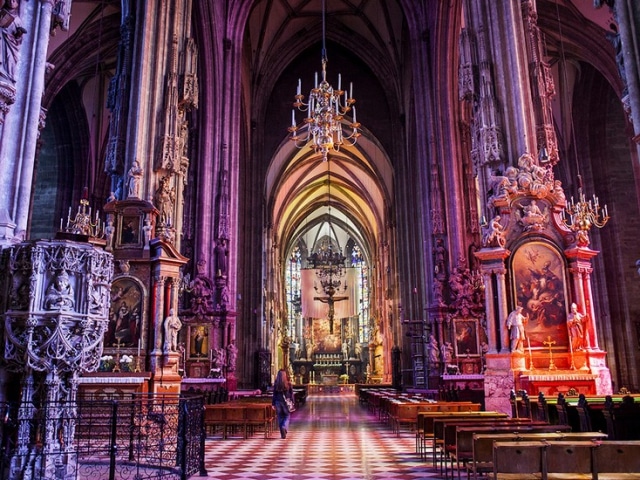
Removed from Unnamed collection
St. Stephen Cathedral 
St. Stephen's Cathedral is the symbol of Vienna. Construction commenced in the 12th century. Today, it is one of the most important Gothic structures in Austria. St. Stephen's Cathedral is 107.2 meters long and 34.2 meters wide. It has four towers. The tallest of these is the south tower at 136.44 meters. The tower room, from which there is a gigantic view across Vienna, is reached via 343 steps. A total of 13 bells hang here. However, the best-known bell of St. Stephen's Cathedral, the Pummerin, is located in the 68.3 meter-tall north tower. It is the second-biggest free-swinging chimed church bell in Europe. On the roof of St. Stephen's Cathedral, colorful roof tiles were laid to create the Royal and Imperial double-headed eagle and the coat of arms of the city of Vienna. The interior of St. Stephen's Cathedral was changed again and again over the centuries, right through to the Baroque period. https://www.wien.info/en/sightseeing/sights/st-stephens-cathedral
Map
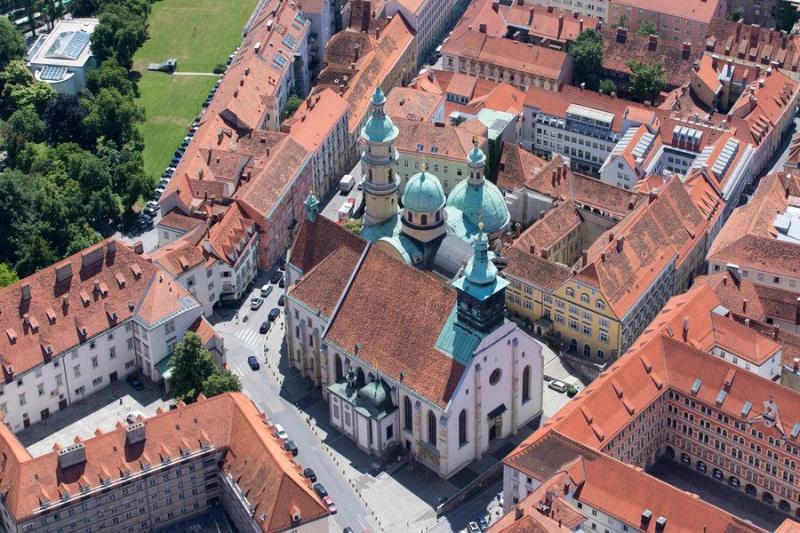
Removed from Unnamed collection
The Cathedral Graz 
Royal-imperial church architecture is crowning the historic city centre. The cathedral is definitely not to be missed on any sightseeing trip round Graz. Don’t be fooled by the relatively restrained exterior. The "Gottesplagenbild", an inspiring relic of splendid Gothic fresco painting, is still in excellent condition today. Inside the cathedral, a multitude of ecclesiastical along with general historical treasures is waiting to be discovered.
Today's cathedral reminds of the days when Graz was an imperial city. Emperor Frederick III erected the church together with his new residence in Graz. In the course of history, the cathedral saw many changes. Construction work of the court and parish church in late-Gothic style was started in 1438, as Jesuit church it was refurbished in Baroque style in the late 17th and early 18th centuries. Since 1786 it has been the cathedral, i.e. the bishop's and main church of the Catholics in Styria.
The exterior of the cathedral looks very sober today. In the Gothic period, however, the façades were covered with paintings. One fresco has been preserved - the so-called Gottesplagenbild ("God's Plagues"). https://www.graztourismus.at/en/see-and-do/sightseeing/sights/cathedral_sh-1241
Map
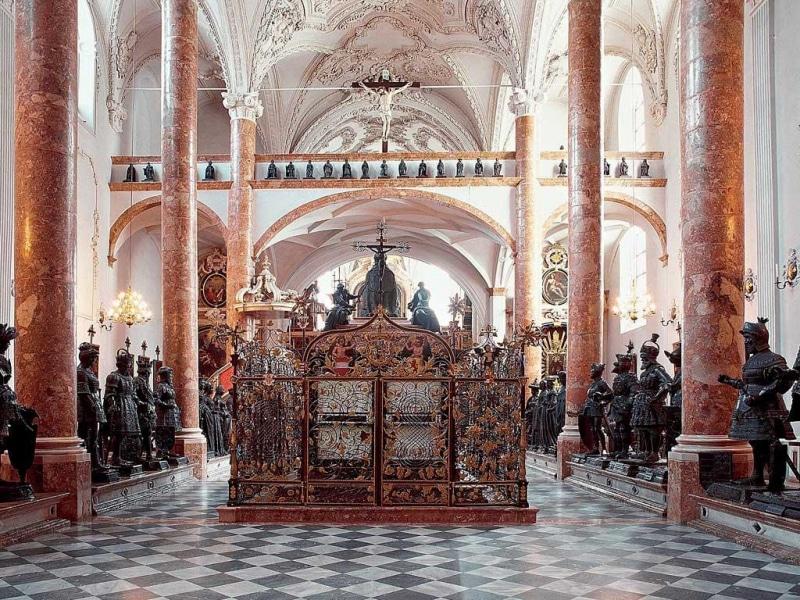
Removed from Unnamed collection
Court Church 
The Court Church is also known by locals as “Schwarzmander Church” thanks to the 28 life-size bronze figures that stand guard, watching over the tomb of Emperor Maximilian I. Strange but true: eight of the “Black Men” (Schwarzmander) are actually women and the Emperor’s tomb is empty. But this beautifully crafted masterpiece is still a work of art and wonderful to behold.
The Emperor’s tomb takes pride of place in the church. However, the building is also home to legendary local heroes, such as freedom fighter Andreas Hofer. In 1809, Andreas Hofer led thousands of brave Tyroleans against the superior force of Napoleonic troops on Bergisel. He was executed for this in Mantua but is still revered as a hero in Innsbruck. The Court Church is also the final resting place of his fellow soldiers Josef Speckbacher, Joachim Haspinger and Kajetan Sweth.
The Silver Chapel is a highlight that shouldn’t be missed on a visit to the Court Church. Two additional famous people from Innsbruck are buried here: Archduke Ferdinand II and his wife Philippine Welser. She was a local superstar during her lifetime: the “Queen of Hearts”, a herbal expert and a bathing beauty who was even accused of witchcraft by malicious tongues. A magnificent silver alter and Madonna by imperial architect Giovanni Lucchese is the main feature of the room alongside another special piece: an organ with pipes made exclusively of wood. https://www.innsbruck.info/en/sightseeing/sightseeing/churches-and-monasteries/detail/infrastruktur/court-church-innsbruck.html
Map

Removed from Unnamed collection
Allsaints Parish Church 
It is presumed that a small chapel existed here as early as in the year 800. The All Saints church was first mentioned in historical documents in 1375. https://www.dibk.at/Media/Pfarren/Innsbruck-Allerheiligen#
Map

Removed from Unnamed collection
Pilgrimage church on Poestlingberg 
This pilgrimage church, dedicated to the Seven Sorrows of the Virgin Mary and perched high above the roofs of the city, is the landmark of the Upper Austrian capital Linz. Just a few minutes' walk from the Pöstlingbergbahn stop, if offers a breathtaking view of Linz.
It was built in 1748 according to plans by Matthias Krinner. The church is popular for weddings because of the unique location. https://www.linztourismus.at/en/leisure/discover-linz/worth-seeing/historical-sites/churches/pilgrimage-church/
Map

Removed from Unnamed collection
Mariendom (New Cathedral) 
The largest church in Austria is situated in Linz – the New Cathedral (also called Mariendom or Maria-Empfängnis-Dom).
Beautiful glass windows decorate the cathedral, which was finished in 1924 and can accommodate 20,000 people. The sacred space is also fascinating. Mariendom is a haven of peace and an architectural masterpiece.
Enjoy the view over Linz from the spire. Or experience the captivating view of the church's interior at a height of 15 metres on a special tour of the church's accessible inner gallery. The tours are also well suited to children aged 5 and above and to families. https://www.linztourismus.at/en/leisure/discover-linz/worth-seeing/top10/mariendom/
Map

Removed from Unnamed collection
Klagenfurt Cathedral & Cathedral Square 
Commissioned by the territorial estates as a Protestant church in 1578, it was designed by architect Christoph Windisch. Klagenfurt Cathedral is the oldest pilaster church in Austria. The 23 paintings on the walls and ceilings were painted over several times in the course of the years.
The Catholic Reformation Commission closed the cathedral in the year 1600. Four years later it was handed over to the Jesuits who managed the Jesuit school next door until the order was closed in 1773. A fire destroyed major parts of the church in the year 1723. Reconstruction did not begin until 1725. The Carinthian Baroque painter Josef Ferdinand Fromiller created the John of Nepomuk apotheosis. The church was raised to Cathedral status in 1787. The Cathedral was renovated in the 1890s and shines today in the lustrous Baroque colourfulness of the 18th century. https://www.visitklagenfurt.at/en/discover-and-experience/worth-seeing/285-klagenfurter-dom-domplatz.html
Map

Removed from Unnamed collection
St.Polten Former Synagogue 
The only Art Nouveau synagogue in Lower Austria. Rich painting in ornamental forms of the Wiener Werkstätte.
Built in 1913 according to the plans of the architects Theodor Schreier and Viktor Postelberg, the synagogue was badly damaged in the Kristallnacht (9th / 9th November 1938). After 1945, the building was returned to the IKG Vienna - an IKG St. Pölten no longer existed. The once thriving Jewish community life in St. Pölten was completely destroyed, only a few survivors returned to St. Pölten.
Since 1988, the Kantorhaus houses the Institute for Jewish History in Austria, which uses the synagogue room for events.Today, the former synagogue is a memorial site that commemorates a living Jewish community before 1938 and its destruction by the Nazis. https://www.stpoeltentourismus.at/ehemalige-synagoge
Map
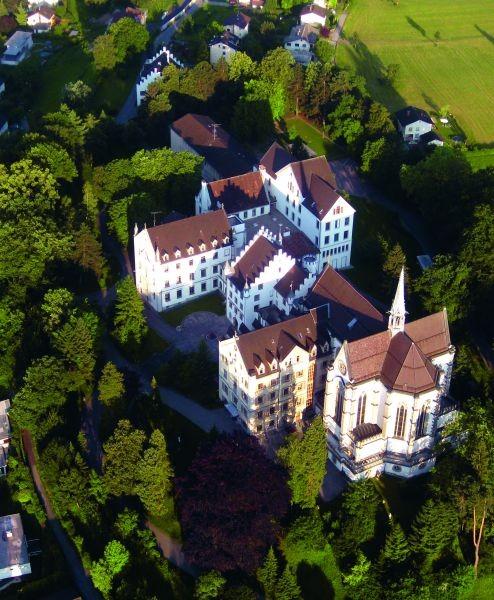
Removed from Unnamed collection
Churches in Bregenz 
Around the turn of the 18th and 19th centuries, Bregenz was still a pronounced baroque city. Today, numerous baroque echoes can still be found in the cityscape. It is primarily church buildings on which the build and design-happy construction style of the 17th and 18th centuries made its mark. https://www.bregenz.travel/en/tourism/experience/tourist-attractions/churches-in-bregenz/
Map
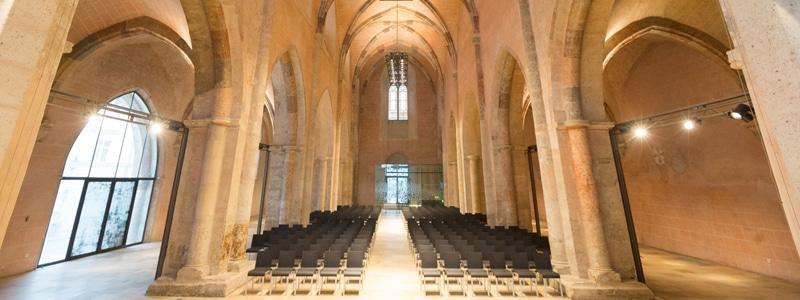
Removed from Unnamed collection
Dominican Church and Monastery 
1236 received the Dominicans of Duke Leopold VI. the order to set up a branch in Krems an der Donau. At about the same time, the Minorites were called to Stein. As early as 1240, the construction of a church was begun , which was vaulted around 1265. It was then built outside the city walls, the so-called Predigertor led through the city wall to Passauerhof with the Ursula chapel.
The chancel of the church dates back to 1330. The impressive sacred space was initially painted colorful, well-preserved remains of which can still be seen today.
The monastery and the church were one of the largest and most representative meeting rooms in the country at the time of construction , serving as a meeting place for the regional parliaments and for meetings of the handicraft mints of the region. The monastery itself was built in the Baroque style and the Gothic cloister was overgrown. A partial reconstruction in the eastern area of the courtyard refers to the disappearance of the gothic colonnade of the complex. http://www.museumkrems.at/Dominikanerkirche.htm
Map
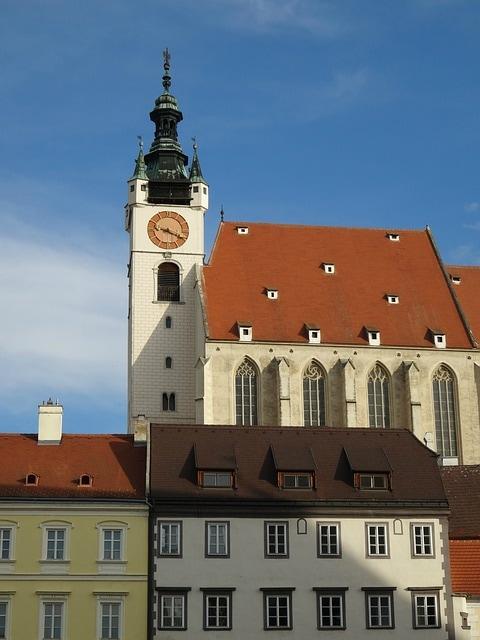
Removed from Unnamed collection
Piarist Church Krems 
This Roman Catholic church is the oldest in Krems and was constructed around 1284.
The late-Gothic hall church is stylistically related to the Vienna Dombauhütte and is therefore also referred to as the "little sister" of St. Stephen's Cathedral in Vienna. Inside, the steep Gothic church with its profiled pillars, services, capitals and many other craftsmanship highlights of Gothic architecture impresses. The baroque high altar was built according to plans by Joseph Maria Götz . The altarpiece is by Martin Johann Schmidt , it is called 1756 and shows the Assumption of Mary.
The watchtower, which was built in the east, has been owned by the city since 1616. It was the seat of the city turret and was inhabited until a few decades ago. Opposite the church portal leads the 2004 completely renovated covered Piaristenstiege to Pfarrplatz. https://www.donau.com/en/wachau-nibelungengau-kremstal/outings-activities/excursion-destinations/abbeys-monasteries-churches/abbeys-monasteries-churches/piaristenkirche-krems/119544fc3f5455620aebd86fb028d324/
Map
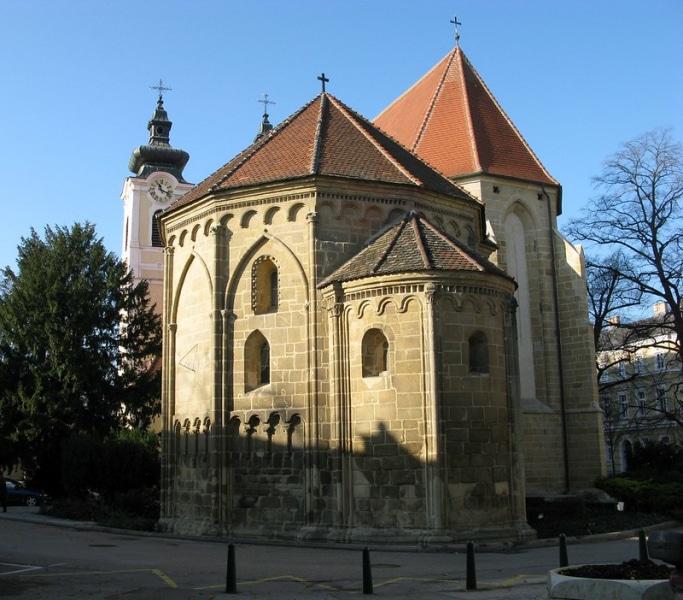
Removed from Unnamed collection
St Stephan 
The Tulln parish church is around 1,000 years old and was among the early parish churches to be established by the Babenbergs. The charter from Emperor Heinrich II dates back to 1014.
The church combines multiple architectural styles. An Ottonian Romanesque core is juxtaposed with a Gothic chancel and Baroque towers and a Baroque interior. Of particular historical note is the Romanesque west portal, known as the Apostles’ Gate. The marble altar and the magnificent choir stalls are also features of the church that visitors will not want to miss.
The two towers are signs of the church visible from far and wide. They have an interesting story. The south tower belongs to the parish whereas the north one is owned by the city of Tulln. In earlier times, the tower watchman had his lookout and abode in the city tower. His job was to ring the bells to warn citizens if a fire broke out within city limits. http://erleben.tulln.at/en/art/major-sights/parish-church/
Map

Removed from Unnamed collection
Haydn Church 
The pilgrim church "Visitation" was built between 1715 and 1803 according to plans drawn up by Prince Paul I. Esterházy. Unfortunately, the prince did not live to see the groundbreaking ceremony as he died from the plague in 1713.
The portion of the church that can be visited today represents merely the presbytery of the church originally planned. It was to be a place of worship of enormous proportions. The high altar picture "The Visitation" is a copy of a painting by Dorffmeister and dates back to 1797. http://www.eisenstadt-tourismus.at/church-of-joseph-haydn.html
Map
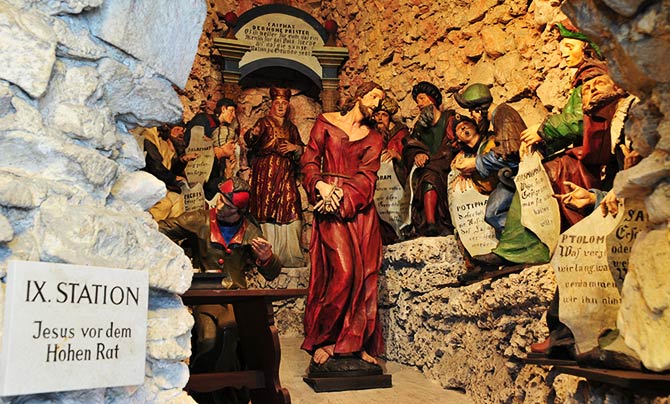
Removed from Unnamed collection
The Calvary 
The famous Calvary at the Haydn church was built by the Franciscan lay brother Felix Niering in the years from 1701 – 1707. The Calvary in Eisenstadt follows the pattern of the Calvary in Maria Lanzendorf in Lower Austria.
Steps and dark hallways lead through an artificial mountain made of rocks and pass by small niches, grottos and tiny chapels portraying scenes of the Passion of Christ.
At the east side of the Calvary, there is the Chapel of Mercy. It contains a miraculous image that is visited by many pilgrims every year. The Chapel of Mercy already forms part of the Calvary. Originally it had been built as Mount of Olives Chapel. After the Statue of Mercy had been transferred from the church in Grosshöflein the chapel was re-consecrated as Chapel of Mercy. https://www.eisenstadt-leithaland.at/en/sightseeing/sightseeing/calvary
Map

